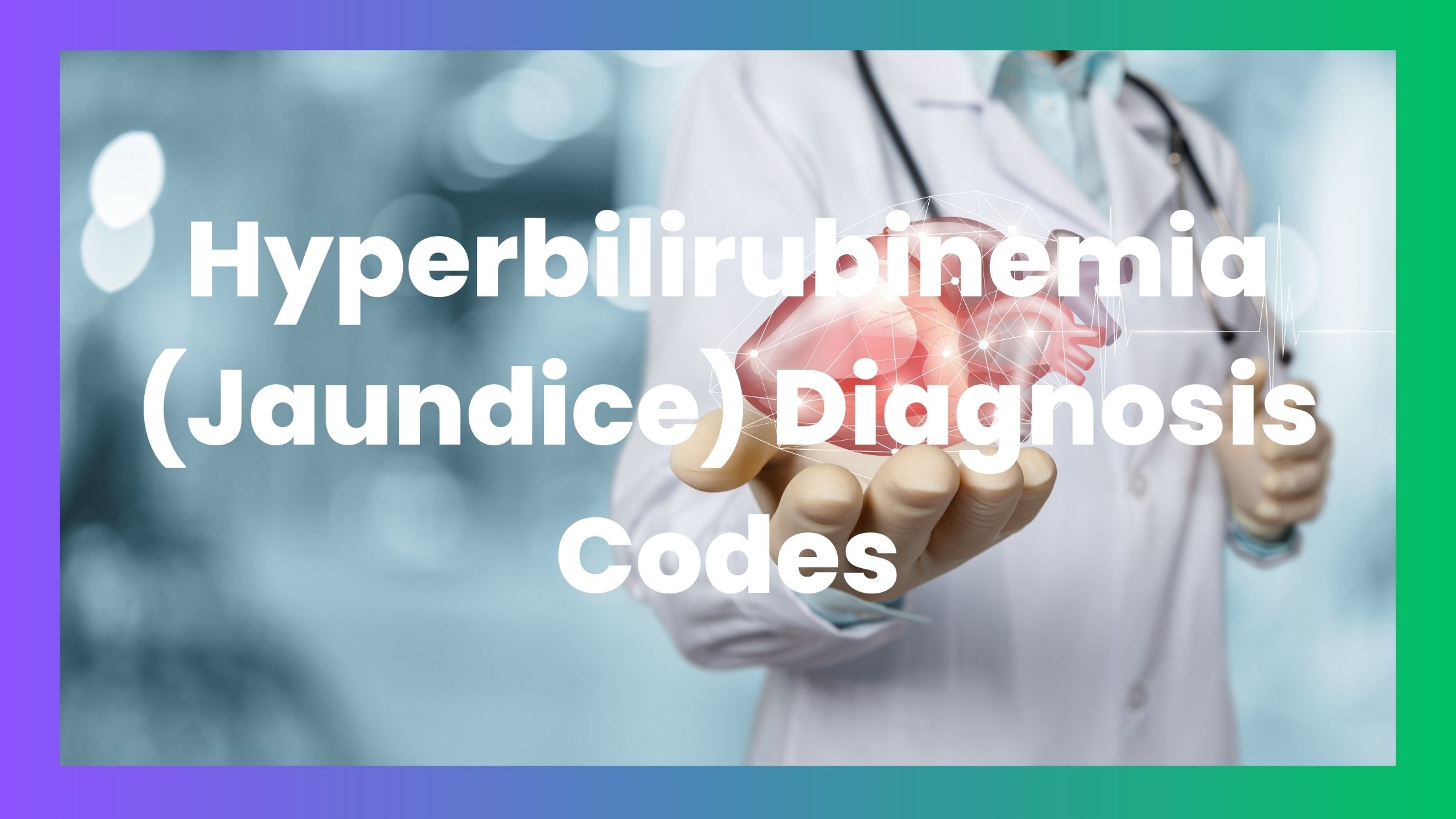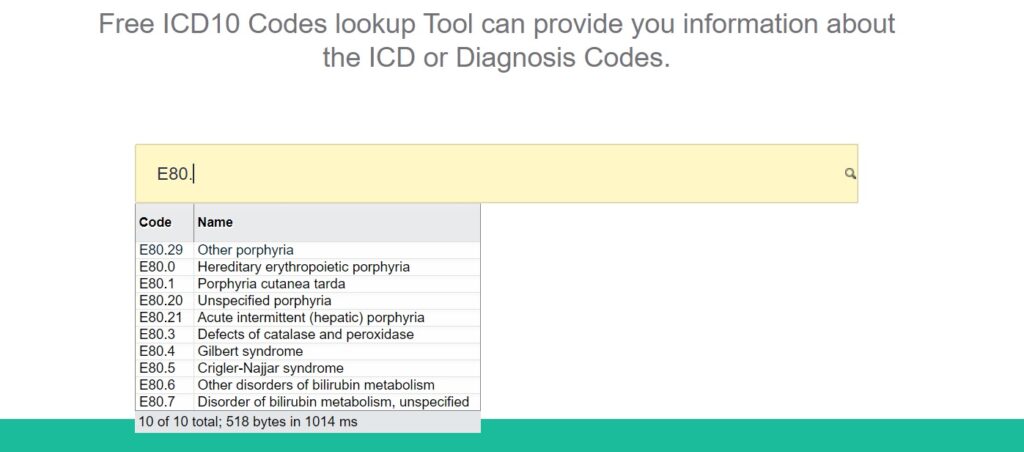Hyperbilirubinemia is a medical condition and in this condition the bilirubin build up in infant babies blood. A substance called bilirubin is formed when red blood cells break down in blood on infant, New born babies have not immunity to get rid of the bilirubin, and it can build up in the blood and other tissues and fluids of baby’s body. This is known as hyperbilirubinemia. Due to bilirubin structure being pigment or coloring, it causes a yellowing of the infant baby’s skin and tissues. This is called jaundice as well. Hyperbilirubinemia icd-10 is E80. 6 and other related ICD10 codes are also mention in below table
Hyperbilirubinemia icd-10 is E80. 6 . The other ICD 10 codes for Hyperbilirubinemia is mention as below,
| ICD Codes | Description |
| E80 | Disorders of porphyrin and bilirubin metabolism |
| E80.0 | Hereditary erythropoietic porphyria |
| E80.1 | Porphyria cutanea tarda |
| E80.2 | Other and unspecified porphyria |
| E80.20 | Unspecified porphyria |
| E80.21 | Acute intermittent (hepatic) porphyria |
| E80.29 | Other porphyria |
| E80.3 | Defects of catalase and peroxidase |
| E80.4 | Gilbert syndrome |
| E80.5 | Crigler-Najjar syndrome |
| E80.6 | Other disorders of bilirubin metabolism |
| E80.7 | Disorder of bilirubin metabolism, unspecified |
| E83 | Disorders of mineral metabolism |
| E83.0 | Disorders of copper metabolism |
| E83.00 | Disorder of copper metabolism, unspecified |
| E83.01 | Wilson’s disease |
| E83.09 | Other disorders of copper metabolism |
| E83.1 | Disorders of iron metabolism |
| E83.10 | Disorder of iron metabolism, unspecified |
| E83.11 | Hemochromatosis |
| E83.110 | Hereditary hemochromatosis |
Cause of Hyperbilirubinemia:
During the period of pregnancy, the placenta excretes bilirubin in the blood and when an infant baby is born, infant’s liver must take over this function. There are multiple reasons of hyperbilirubinemia and jaundice, as below mention
- physiologic jaundice: Physiologic jaundice occurs as a “normal” response to the baby’s lack of ability to excrete bilirubin in the first initial days after birth due to the immaturity of the liver. It is usually resolved by the first week of life.
- During the first few days after the birth when the maternal breast milk supply is low and the baby is having trouble latching and breastfeeding, due to this infant may become dehydrated. Bilirubin is eliminated in the urine and stool and decreased urination with infrequent stools result in a buildup of bilirubin.
- breastfeeding jaundice: Approximately 2% of breastfed infant babies develop jaundice after the first week of birth. It is mostly about two weeks of baby’s age and can persist up to 3 to 12 weeks. Breast milk jaundice occur in infants due to a substance in the breast milk that increases the reabsorption of bilirubin through the intestinal tract.
- jaundice from hemolysis: Jaundice may occur in infant baby in initial days of life due to an increase of red blood cell breakdown (hemolysis) . It is seen when mismatch of maternal and fetal blood type, resulting in ABO incompatibility or hemolytic disease of the newborn .
- No proper functioning liver : due to infection or other factors the liver of infant may not actively work in proper manner due to this issue hyperbilirubinemia may be occured.
Who is affected by Hyperbilirubinemia?
Hyperbilirubinemia is very common, affecting approx 60 % of newborns and approx 80 percent of premature babies develop jaundice.
Symptoms:
- Elevated bilirubin is showing as yellow discoloration of the baby’s eyes, mucosa and skin, usually starting from the head and moving downward.
- poor feeding or lethargy
Related Articles:
Blue Cross Blue Shield Denial Codes |Commercial Ins Denial Codes
ICD 10 code Anemia |Diagnosis code for Anemia
List of New ICD-10-CM Codes Added in 2021
- New ICD-10-CM Covid-19 Codes Apply from 1-JAN-21
- List of New ICD-10-CM Codes Added in 2021
- List of Deleted ICD-10-CM Codes in 2021
- ICD 10 Code for Secondary Cardiomyopathy (2024)
- ICD 10 Code for Radiculopathy (2024)
- Alcohol Withdrawal ICD 10 (2024)
- ICD Code 10 For Suture Removal (2024)
- Gestational Diabetes icd-10 (2024)
- ICD-10 for Osteoporosis (2024)
- UTI ICD 10 Codes |Urinary Tract Infection ICD (2024)
- Pneumonia ICD 10 | ICD-10-CM Code for Pneumonia (2024)
- Anemia ICD 10 code | Anemia in Chronic Disease (2024)
- ICD 10 Code for HIV|AIDS Disease ICD-10 Code (2024)
- ICD 10 For Fever| Cause, Symptoms and Protection from Fever
- Hemorrhoids ICD 10 Code | What is Hemorrhoids Medication (2024)
- ICD 10 code Anemia |Diagnosis code for Anemia (2024)
- ICD 10 Code for Obesity| What is Obesity ?
- ICD 10 Code for Insomnia |What are the main causes of insomnia?
- ICD-10 code for Fatigue (2024)
- Hyperlipidemia ICD 10 Code (2024)



